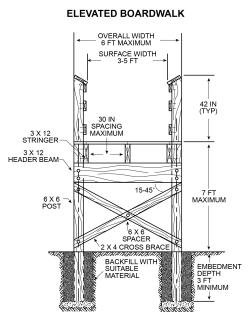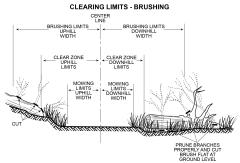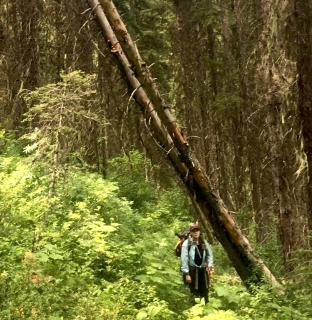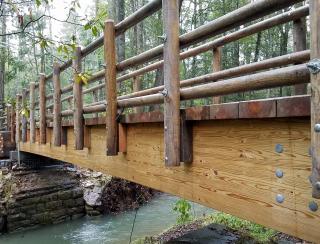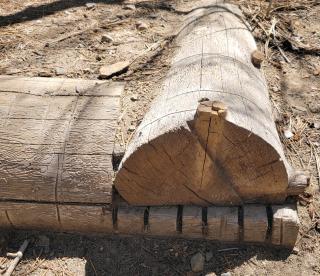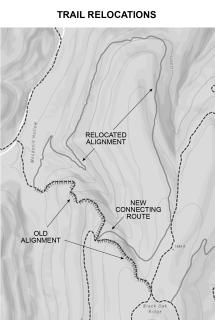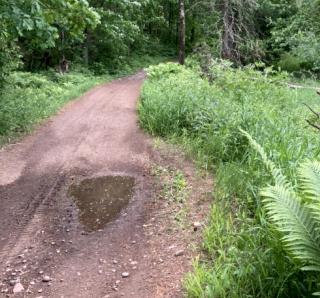Trail Management Toolbox - Terms
Below is the agency’s online dictionary of common trail terminology, with definitions, photos and illustrations.
These terms may appear in various trail publications and Forest Service policy. If there is a conflict in the definition, Forest Service policy is the authority. Many of the diagrams or illustrations are adapted from engineered plans featured on the Plans for Trail and Trail Bridge Structures web page.
For More Information
Please contact Forest Service Trail Management if you have questions or comments.
A hiking trail that meets the technical design requirements described in the Forest Service Trail Accessibility Guidelines (PDF, 1.83 MB).

A trail with design characteristics that allow people with mobility disabilities to use them, typically with the assistance of adaptive riding equipment.

The section of trail on either end of a structure that rise in a ramp or steps 2-8 percent to meet the structure deck to prevent water from flowing and depositing soil and debris onto the bridge.

The practice of "hardening" the trail tread with large rocks laid flat that create an exceptionally durable tread that resists erosion, compaction, and displacement.

Axe with two symmetrically opposed cutting edges. One edge is maintained at razor sharpness. The other edge is usually duller and used to chop around rocks or in soil. Mark the duller edge with a spot of paint.

Axe with a single cutting blade and handle that is used for felling and splitting.
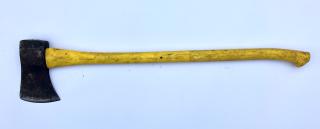
The excavated area of the hillside above the tread surface.
The amount that a vertically stacked structure (typically a wall) leans back towards whatever it’s holding up, often referred to as a ratio between the amount of rise and the amount of run.

The section of the trail tread cut into the hillside that provides a firm and stable surface.

The mound of soil that typically forms on the outside edge of the tread as water and trail users displace and compact the soil.

The shape and angle of the cutting edge of a blade that influences the type of cut and how long the blade will remain sharp after use.

A small triangle typically made from plastic or metal affixed to trees or posts to mark the trail route.

A typically wooden structure less than 7 ft tall with railing, decking, posts, that elevates the tread above seasonally or perennially saturated soil.
The basic structure is a plank tread surface resting directly on sills, cribbing, or piles. Note the name for this structure varies.

A trail bridge is a structure, erected over a depression or obstruction such as a body of water, a road, a trail, or a railroad that provides a continuous pathway and that has a deck for carrying traffic or other loads. They range from a simple foot bridge to multi-span, suspended, and truss structures.

Cutting out a cross-section of a fallen tree to make smaller, more manageable sections.
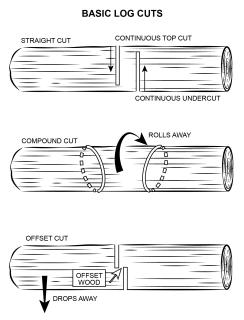
Curb and bull rail are two names for a barrier along the sides of a boardwalk or puncheon.

A stacked rock structure used to mark less-developed trails in open areas where low visibility or snow cover makes it difficult to follow the tread or where the tread is rocky and indistinct.

A log or rock and earthen structure that elevates the trail tread above the seasonally wet areas. It is also considered a turnpike without ditches.

Toolhead that attaches to the chainsaw bar and uses cutting blades that are rotated by the chainsaw chain for debarking, planning, jointing, and notching logs.

Earthen, log, or rock retainment structure built perpendicular to the trail that slows water velocity forcing it to deposit sediment.

The height of the clearing limit within the trail corridor measured vertically from the trail tread.

The area over and beside the trail tread within the trail corridor that is cleared of trees, limbs, and other obstructions.
The width of the clearing limit within the trail corridor measured perpendicular to the trail.

A reverse in direction of the trail grade without a level landing that is used to change elevation on a steep slope.
A handheld device, also called a “clino”, used to measure the grade (percent) or angle (degree) of a trail segment or hillside.
A trail bridge made of a wood, metal, or other material that uses trusses, suspension or other multiple spans that is appropriate for fully developed trails (class 5). It requires in-depth training and certification to inspect and should be inspected every five years.

The result of trail users or wildlife using the outside edge of a trail on a hillside and migrating the trail farther down the slope, narrowing the tread.
A wooden retaining wall made from logs or dimensional lumber. The structure can support the trail tread or hold fill material back from the tread.
The ratio of vertical rise to trail width when measured from one trail edge to another perpendicular to the direction of travel.
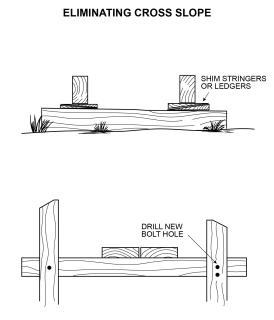
A two-person saw with a stiff and heavier blade that has a straight-shaped back that is used for bucking or cutting logs on the ground.

A two-person saw with a light and flexible blade that has a concave-shaped back that is used for felling standing trees.

A crosscut saw with a handle on one end that requires only one sawyer.

Bottomless arch culverts require less vertical space and has a natural streambed bottom that is preferred for aquatic organism passage. Work with hydrologists to determine the best type and size of culvert to fit your needs.

A hollow structure made of large rocks placed in the ground that allows low to moderate flows to pass under the trail.
A linear feature of wood, concrete, or stone placed or affixed on the sides of a trail. The curb can rest on the trail tread or elevated a few inches on scupper blocks.
A channel of appropriate size and grade that facilitates the unobstructed flow of water and transported sediment that extends far enough away and downhill from the trail where water can continue to flow down the natural hillslope without being able to return to the trail tread in another location. In an appropriately shaped channel, the flow of water and sediment will be adequate to "self-clean" the drain without undercutting the trail.

Demolition, dismantling, removal, obliteration and/or disposal of a deteriorated or otherwise unneeded asset or component, including necessary cleanup work.
The trail dozer is commonly used to cut in full-bench trails, during heavy maintenance to repair trail tread and reconstruct rolling dips, and during decommissioning to reshape and naturalize the old trail tread.
An earthen structure with a low point that directs the flow of water with enough velocity to wash sediment out of the drain, keeping it clear and requiring less frequent maintenance. The drainage outslope should be maintained greater than 5 percent to self clean.

A hand-held tool with a blade affixed between two handles this is designed to peel dry logs.
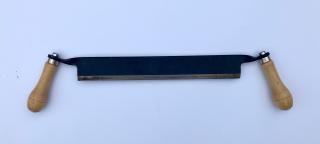
A length of rebar or steel pipe driven through predrilled holes in a timber or log and into the ground to the secure the structure to the ground. Drift pins should be driven into the ground at least 18 inches and be countersunk into the structure to avoid protruding.
Leaves, sticks, and other organic material that accumulate above the mineral soil layer.

Removal of soil by water, wind, other natural forces and trail users.
The path that follows the most direct route downhill.
Files come in single or double, curved or rasp cuts. Single-cut files have one series of parallel teeth angled 60 to 80 degrees from the edge; they are used for finishing work. Double-cut files have two series of parallel teeth set at a 45-degree angle to each other; they are used for restoring shape. Curved and rasp files have elevated teeth that are used for shaping metal and wood respectively.

The material excavated from a bench cut into a hillside that is compacted to create the outside of the trail tread.

A surface that is not noticeably distorted or compressed during the seasons for which it is managed, under normally occurring weather conditions, by the passage of a device that simulates a trail user in a wheelchair.

A method of constructing a grade reversal within the existing trailway that elevates or lowers the trail tread resulting in a forced uphill grade to force water off the trail.
Shallow stream crossing for low and moderate flows that provide users with solid, level footing or driving surface at a consistent depth from one bank to the other without blocking passage for fish and other aquatic organisms.

Describes a type of trail construction where the full width of the trail is excavated from the hillside to create the trail tread.

Wire mesh containers filled with angular rock that serve as retaining walls, foundations, and other structures.
Grade reversals (a.k.a. grade dips, terrain dips, break in grade, undulations, or swales) are areas along a trail where the trail grade reverses or changes in the opposite direction—up or down. The reversal or rise (crest) and fall (dip) of the trail are repeated as it traverses the hillside. The crest must be tall enough to divert anticipated water flows off the trail while not creating a trail jump.
A grubbing and shaping tool with a blade perpendicular to the handle that is used to break up sod clumps during new trail construction or when leveling an existing trail tread.
The “half rule” refers to a practice of keeping a trail grade less than half of the hillside slope to reduce erosion potential. The half rule becomes less relevant on hillsides with greater than 14 percent slope, because trails on steeper hillsides should still average less than a 7-percent grade.

Handheld tool with a head forged from heat-treated, high-carbon steel weighing 8–20 lb. (3.6–9 kg).
Handheld tool with a head forged from heat-treated, high-carbon steel weighing 2–5 lb. (0.9–2.3 kg).
A hazard tree is a standing tree that has a structural defect such as deterioration or damage to the root system, trunk, stem, or limbs and could hit a target such as people or property. Not every hazardous tree along a trail needs to be removed. Hazard tree mitigation should go up as the trail development scale goes up.
Erosion on an upstream wall of a waterway formed by unstable drainage, mainly from water leaving a drainage too quickly or free falling (waterfall).
The oldest wood of a tree, extending from the center of a log to the sapwood. The heartwood is the densest, strongest, and darkest wood in a log.

A solid steel shaft 1.5 to 2.5 inches in diameter with a series of steel helixes welded to the shaft. The helixes are similar to threads on a bolt or the threads on a powered earth auger. The helical piles or screw piles can range from 6 to 30 inches in diameter. A machine is required to screw them into the ground.
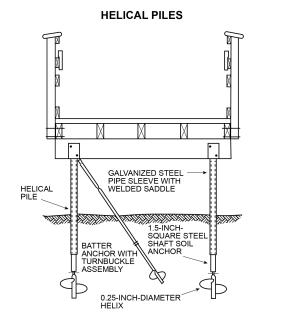
The way surface water moves into and through the soil. The amount of infiltration affects how much water is available for plants and how long water will remain in or saturate the soil.
The bottom surface of a pipe, ditch, or culvert over which water flows.

Semicircular drain constructed with exaggerated outslope to shed water off existing trails on hillsides.

A horizontal piece of wood attached to, and supported by, piles or concrete or stone masonry piers. The ledgers support stringers or tread timbers.

The first type of log dog is a broad U-shaped steel bar 18 to 30 inches wide, with pointed ends, which is used to temporarily hold two logs at right angles to each other. The second type of log dog is smaller and easier to pack. It consists of a 6-inch to 12-inch-long steel plate that is 2 to 3 inches wide and pointed at each end. A second steel plate (3 to 6 inches long, identical width, pointed at one end and straight on the other) is welded across the center of the first to form a “T”.
Logs or dimensional lumber in crib walls and other vertical trail structures are notched so they fit tightly together and increase the stability of the structure.
Logging out a trail means cutting (bucking) and removing trees or sections of trees that have fallen across it.
Cutting tool with long handles used for cutting small limbs, and brush unreachable or larger than can be cut with hand shears.
Wood that has been sawed into a square or rectangular cross section.

A trail bridge made of a single timber span more than 20 ft (6 m) that is appropriate for developed to fully developed trails (class 3–5). It requires training and certification to inspect and should be inspected every five years.
Two-sided grubbing and cutter tool with a long handle. One side is a hoe and the other side is a smaller axe blade.
Two-sided grubbing tool with a long handle. One side is a hoe and the other is a pointed pick for breaking up hard soil and digging up rocks, while the grubbing blade works on softer materials.
A trail tool that combines a heavy-duty rake with a large and sturdy hoe.
A versatile piece of mechanized equipment that can be used to excavate the bench, shape the tread and backslope, and move building material, debris, and rocks from place to place.
A trail bridge made of a single timber span less than 20 ft (6 m) that is appropriate for minimally to moderately developed trails (class 1-3). It requires training, but no certification, to inspect and should be inspected every five years.
A modified climbing turn is constructed on hillside slopes steeper than 25 percent. The turning area is “flattened” so the steepest trail grade through the turn is approximately 20 percent. Flattening the turn is accomplished by building up the lower leg and cutting down the upper leg to reduce the grade on the turn. The turning radius ranges from 5 to 10 ft (1.5 to 3 m) wide—on the wider side if the trail is open to wheeled traffic or used by long pack stock strings.
A strip of wood attached to a stringer that tread planks are nailed or screwed to.
Trails constructed with a pervious tread surface made of rock, soil or aggregate.
A notch cut in a log to fit snugly against a square notch cut in another log, the square cut end of another log, or a plank. The portion of the notch in contact with the other log is cut as a flat, uniform plane. The end or ends of the square notch are perpendicular to the flat plane.
A gap lined with large rocks across a trail that allows water to pass from one side to the other. The open top should be wide enough to accommodate the water flow and narrow enough for someone to step over.
The outsloped tread on a trail on a hillside is lower on the outside or downhill side than on the inside or bankside. Out sloping allows water flowing down the hillside to sheet across the trail instead of being captured and focused to run down the trail.

Describes a type of trail construction on a hillside where the inside portion of the trail tread is excavated from the hillside and the outside portion is made from compacted fill.

Piers are used to support one or both ends of a beam or stringer. Piers may be timber or log cribbing or piles, helical piles, stone masonry, or concrete and are typically above ground.

Hand operated or machine powered device that drives metal piles and posts into the ground.
A set of tools driven into a line of pre-drilled holes that will eventually split a rock.
Removing heavy branches is a three-step process. Make the undercut on the underside of the branch (A). This keeps the cut branch from peeling bark off the bole (or trunk) of the tree. Then make the upper cut (B), slightly to the outside from the undercut. Lastly, cut the remaining stob at an angle close to the branch collar (C-D).

Two-sided grubbing and cutting tool with a long handle. One side is a hoe and the other is a full-size axe blade.
Puncheon with made with 2 to 3 stringers separated by a space with deck boards nailed perpendicular to the direction of travel.

A vertical barrier made of posts and horizontal rails on the side of a trail that keep trail users from falling off the edge of the trail. The requirements for the number of rails and rail spacing vary.
A structure that holds back soil or other materials from falling or collapsing made of rock, timbers, concreate, steel, and other materials.

A heavy-duty metal bar (also called a pry bar) used with a fulcrum for lifting, flipping, or sliding large, heavy objects.
A specialized gas-powered cutting tool designed to shape rocks into a desired size and shape.
A trail designed and constructed to follow the natural contours of a hillside with frequent grade reversals or the rise (crest) and fall (dip) to allow water to drain from the trail tread minimizing erosion.

A constructed section of trail where the trail grade reverses in direction for a short distance, creating a reversal in grade or the rise (crest) and fall (dip) and creates a depression that allows water to flow off the trail via an outlet. It is typically constructed on steep trails with a consistent trail grade in one direction. The structure will require maintenance.

A depression in the outlet of a rolling grade dip that is designed to catch eroded material that can be reused in routine trail maintenance. Consider increasing the number of rolling dips if the sediment basin fills in less than 3 years.
A wet area where water reaches the surface, mainly through sedimentary rock layers.

The way water is dispersed down a hillside without concentrating into channels.

The most common shovel. It has a round-point head for digging and moving excavated material.
Shovel with a square, flat-bottomed head intended for shoveling loose materials, not digging.
A trail with a tread excavated into the side of the hill.
Sign posts made of wood or pipe should be buried 30 to 36 inches deep with a perpendicular anchor bolt to discourage theft and increase stability.

Smaller mechanized trail building equipment (used in landscaping) that comes with a variety of attachments for pushing, shaping, and lifting. The versatility makes the skid steer the “Swiss Army knife” of mechanized trail equipment. It is also lighter than other pieces of trail equipment and towing doesn’t require a commercial driver’s license.
Soil, rock, and debris that has moved from the slope above the trail downhill to the inside of the tread, narrowing the tread.
Clay soils hold water and swell when wet. They can create a strong tread when combined with gravel and rock.
Loamy soil is a mixture of sand, silt, and clay and is great for trail building.
Sandy soils are easy to drain, but don't bind well together and are not desirable for trail building.
Silty soils hold water when they are wet and are floury when dry. They are best suited for trail building when mixed with gravel and rock.
Organics mixed with mineral soil (silt, sand, and clay). The percentages of the mineral material determine how a trail drains water and how it holds up under use. The mix greatly affects how trails are designed, maintained, and managed.
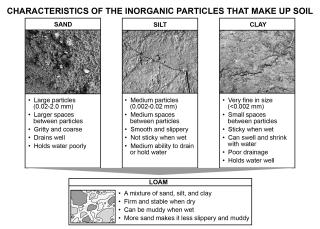
Long description of illustration. Title: Characteristics of the Inorganic Particles that make up soil. First description, left: SAND. Characteristics are, large particles (0.02-2.0mm); larger spaces between particles; gritty and coarse; drains well; holds water poorly. Top center: SILT. Characteristics, medium particles (0.002-0.02mm); medium spaces between particles; smooth and slippery; not sticky when wet; Medium ability to drain or hold water. Right: CLAY. Characteristics, very fine in size (<0.002mm); small spaces between particles; sticky when wet; can swell and shrink with water; poor drainage; holds water well. Bottom-Center: LOAM. Characteristics, a mixture of sand, silt, and clay; firm and stable when dry; can be muddy when wet; more sand makes it less slippery and muddy.
Stones placed in a line to provide dry passage across a shallow stream that are large enough to withstand displacement by the force of high-water events.
Overlapping steps made from flat rocks embedded in a hillside.
Overlapping steps made from timbers and fill material that is embedded in a hillside.
The remaining cut end of a tree branch or sapling.
A technique to armor or "harden" the tread used when available rocks are not heavy enough to withstand use forces if laid flat. Instead, each rock is “pitched” or stood on the long axis and buried deeply to provide greater anchoring and strength.
When streamflow in a high-water event is diverted down a trail because the approach is not steep enough.
How well the trail and trail features withstand the impacts of users and anticipated extreme weather events and natural disasters without contributing to resource damage, and without needing more than routine maintenance. Physical sustainability is part of environmental sustainability.
A constructed turn that includes a circular or rectangular shaped platform that follows a “zigzag” pattern primarily used to gain elevation on steep hillsides.
A minimally developed (class 1) trail has an inconsistent tread and native surface.
A moderately developed (class 2) trail has a rough and narrow consistent tread; obstacles can be continuous.
A developed (class 3) trail has a consistent tread and less-frequent obstacles; imported materials may be present.
A highly developed (class 4) trail has a wide and smooth tread, trailside amenities, and likely meets accessibility guidelines.
A fully developed (class 5) trail has a firm and uniform tread, less than a 5-percent grade, and likely meets accessibility guidelines.
Constructing a new alignment of an existing trail outside the trailway.
An earthen structure with log or rock retainers that elevate the trail tread and ditches that direct water away from the tread in an area of saturated soil.
Complex rock and earthen structure that allows water from small springs or seeps to flow under the tread surface. They can be constructed with and without slotted plastic pipe. The slots should only be on the top half of the pipe.

Severe bend in a piece of lumber or timber making it unusable in its original length. The warp can be in different directions. Sometimes the warp occurs mostly at one point, usually a knot, and short usable pieces can be cut on either side of that point.
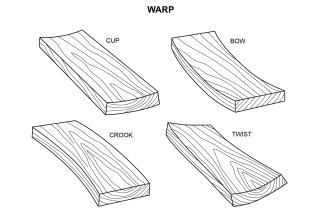
A linear feature made from embedded rock or wood set at a 45- to 60-degree angle across the trail tread to direct water off the trail. They should only be used on minimally developed (class 1) hiking or equestrian trails where obstacles are appropriate.
The level below the ground surface where groundwater will fill a test hole.

Trail widening commonly occurs in muddy, fall line, and flat areas when traffic skirts the edge and tramples the vegetation and compacts soil beyond the edge of the trail tread.




